Strategies for Achieving the Lowest Possible Detection Limits in ICP-MS
Spectroscopy
A laminar flow box for sampling is combined with a positive voltage on the skimmer cone to reduce detection limits to pg/L concentrations in ICP-MS. These improvements reduce the risk of contamination and increase the efficiency of ion sampling and focusing.
This column describes ways of reducing the risk of contamination during sample handling in inductively coupled plasma mass spectrometry (ICP-MS) by using a laminar flow box for sample preparation. In addition, a novel instrument design, such as the ability to apply a positive voltage on the skimmer cone, enhances the efficiency of ion sampling and focusing. This opens up the capability of ICP-MS to extremely high sensitivity and the ability to quantify elements at pg/L concentrations, which is exemplified by the determination of a suite of transition metals and rare earth elements.
Mass spectrometry coupled with inductively coupled plasma (ICP-MS) is capable of analyzing almost the entire periodic table of elements in many different sample matrices. The current generation of instruments offers detection limits for some elements at the picograms per liter (pg/L) level. However, in the determination of trace and ultratrace elemental concentrations, careful consideration must be given to sample handling, in addition to how the sample solution is presented to the instrument, to fully exploit the detection potential of ICP-MS technology.
The limit of detection (LOD) is defined as the lowest quantity that can be distinguished from a blank with a certain confidence level (typically 99%). It is typically defined by many standards organizations as the minimum measured concentration of a substance that can be reported with 99% confidence that the measured concentration is distinguishable from the blank results (1). This means that there is a probability of about 1% for a false positive error (α), meaning a 1% chance of assigning a signal originating from the blank to an analyte. However, at this concentration, there is a 50% chance of assigning an analyte signal to the noise (false negative error (β) = 50%). For that reason, and to minimize the false negative errors, the limit of quantification (LOQ) is often estimated as the concentration, which gives a signal as high as 10x noise of the blank solution measurement above the blank intensity. Hereby the factor 10 is historically established, and commonly chosen in analytical chemistry. The relationship between noise, LOD, and LOQ is schematically shown in Figure 1. This shows that at an equal blank contamination, a sensitivity advantage of a factor of 10 provided by the ICP-MS instrument, enables significantly lower method LODs to be achieved as compared to lower sensitivity instruments. This is especially important because a major source of contamination is the sample preparation and the reagent chemicals used, as well as the laboratory environment in general. These sources of contamination are independent from the ICP-MS instrument used, and can significantly degrade the LOD if not minimized.
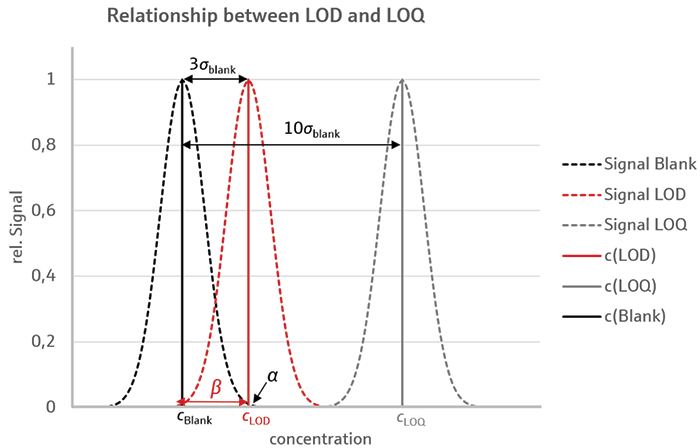
Figure 1: Relationship between noise, limit of detection (LOD), and limit of quantification (LOQ). The parameter α denotes the concentration at which the probability of assigning a blank signal (black) falsely to an analyte equals 1% (false positive error). At this concentration, there is a 50% chance of assigning an analyte signal (red) to the noise (β, false negative error).
Influence of Laboratory Environment, Purity of Reagents, and Cleanliness of Equipment on the LOD
The contamination of the blank solution has a significant impact on the resulting LOD. Sources for contamination include leaching of elements from flask and container walls and caps, the purity of the reagent chemicals or acids used, and dust particles from the laboratory environment. Common ways to minimize these effects include conditioning the flasks with an acid solution (for example, 1% HNO3), and the use of a laminar flow box for sample preparation, as well as autosamplers covered with a dust box including a HEPA filter. The principles of laminar flow are shown in Figure 2.
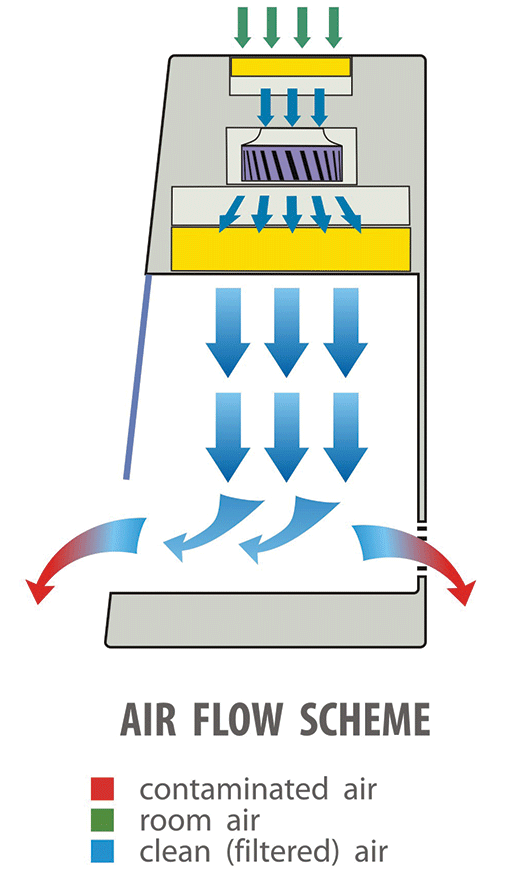
Figure 2: Principles of a laminar flow box used in this study.
A laminar box draws the ambient air and pushes it through a filter and flow straightener. Because the air streams in parallel flow lines, particles are picked up and transported out of the box through the perforated bottom. This lowers the particle concentration by factors of 10,000, minimizing the risk of sample contamination by ambient particles in the laboratory environment. The flow box can be placed onto a common laboratory bench for easy setup of a clean preparation area in an already setup laboratory. Stand-alone flow boxes are an attractive solution if a laboratory is built-up or renewed.
If the lowest possible detection limits are required, high purity chemicals and acids should be used. Acids can be further purified in dedicated sub-boiling distillation systems. Commercially available high purity acids provide less than 10 ppt of contamination, but are relatively expensive. A careful sub-boiled acid originating from a more affordable reagent grade quality will have equal or even lower contamination levels.
The tubes used for sample collection, storage, and preparation require special attention as well. The acidic sample matrix can leach elements from the colored caps, resulting in contamination for certain elements like chromium, cobalt, barium, or lead. The tubes should always be washed and conditioned with the acidified blank to remove minor contaminations.
For automated sample introduction via autosampler, the tubes should be kept closed as long as possible before analysis. Placing the autosampler into a cover with filtered air using a HEPA filter drastically reduces the particle concentration inside the sampler area, and thus minimizes the risk of contamination while waiting for analysis. The sample-containing tubes should only be opened once placed in the autosampler, and the cover subsequently should be closed.
Materials and Methods
Samples and Reagents
All sample preparation steps were performed in a laminar flow box (Cleanboy, Spetec GmbH) (2).
Sample tubes and containers were conditioned with 1% HNO3 overnight, and carefully rinsed with deionized water before use. For this study, all samples and standards were prepared using high purity reagents. The standards and blanks were made with deionized water < 0.055 mS (ELGA Lab) and 1% HNO3 (ultrapure quality, Merck), as this is frequently used to stabilize the elements. A diluent solution was prepared into a 1 L PFA bottle, and used to prepare all dilutions and blanks. This procedure ensures a constant trace contamination level for all solutions analyzed in this study.
The limits of quantification were determined in the first step. Calibration solutions for calibrations with at least five levels were prepared from a multi-element stock solution for transition metals and rare earth elements, with the lowest standard having a concentration close to the limit of quantification.
Instrument Settings and Method Parameters
The ICP-MS instrument used in this study (PlasmaQuant MS, Analytik Jena) (3) was carefully optimized to provide best sensitivity and lowest background levels, such optimization as this is crucial for achieving the best detection limits.
Plasma Optimization
The inductively coupled plasma generates the analyte ions using an argon plasma as the ionization source. Therefore, the efficiency of coupling the high frequency into the plasma is crucial to maximize the degree of ionization. The plasma system used in this technology achieves a coupling efficiency of more than 85%. A proprietary configuration of coil and plasma reduces unnecessary overheating of the torch, hence decreasing the required coolant gas flow significantly. As a result, this allows the plasma system to run at 7.5 to 10 L/min coolant gas, compared to 16–18 L/min on other ICP systems, without affecting plasma robustness and efficiency. The forward radio frequency (RF) power is permanently monitored, and the frequency is automatically adapted if the impedance changes due to variations in the sample matrix.
A common performance criterion for plasma systems is the efficiency of ionization at the formation of plasma-based molecular ions, like oxides and double-charged species, which is typically evaluated by measuring the formation of cerium oxide to the cerium ion (CeO+/Ce+), or the barium doubly charged to singly charged ions (Ba++/Ba+). All ratios should be well below 3%, although much lower levels can be achieved by sacrificing sensitivity. The plasma system used in this study has an oxide performance (CeO+/Ce+) of 0.5%; however, maximum sensitivity is obtained at approximately 2% oxides.
Ion Optical System
Sensitivity in ICP-MS also depends on the efficiency of ion sampling from the plasma and ion focusing into the mass analyzer and detector. Therefore, the ICP-MS ion optical system is a key component that determines the performance of the entire system. The central part of the ion optics system in the technology used in this study is an ion mirror that generates a parabolic electrostatic field which reflects analyte ions around 90°. All neutrals pass the electrostatic field unaffected, and are removed by the vacuum system. The reflecting system allows for an optimization of the focus point of the analyte ions into the entrance lens to the quadrupole mass analyzer. This makes it possible to influence the overall sensitivity of the mass spectrometer, as well as the sensitivity for certain regions of the mass spectrum. In particular, the lower or upper mass range can be selected, and the method optimized for special applications, such as the determination of isotope ratios of lithium or boron at the low mass end or lead, uranium, and other elements at the high mass range.
The method used for this study was optimized for high sensitivity across the whole mass range to achieve best possible detection capability for all elements. A sensitivity of more than 1.2 million cps for 1 µg/L (ppb) for indium was obtained, while the formation of oxides and doubly charged ions was well below 2% and 3%, respectively.
Interference Management
The ion beam entering the mass spectrometer does not only contain single positively charged analyte ions or neutral species, but also polyatomic ions that interfere with the analyte elements and masses. Collision-reaction cells (CRCs) are commonly used to eliminate these interferences. The technology used in this study uses the integrated collision reaction cell (iCRC) (4) to eliminate polyatomic ions by collisions with helium. The helium injected into the cell that is integrated into the skimmer cone reduces the kinetic energy of the polyatomic species, which are subsequently separated from the ion beam by kinetic energy discrimination. In addition, hydrogen is used as a reaction gas that converts the polyatomic molecules in other species that are not interfering with the analytes. This mode can be combined with the "boost" mode, which applies a positive voltage to the skimmer cone to retain the sensitivity in reaction cell mode by refocusing the ion beam (5).
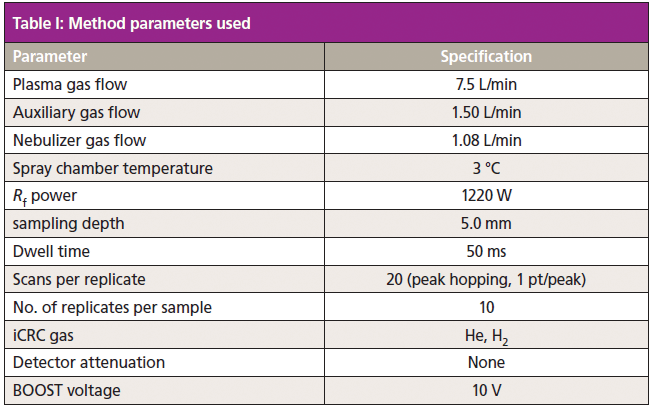
Elements that are not subject to polyatomic interferences were measured in no-gas mode. Argon-based interferences were removed by injecting hydrogen via the iCRC, while helium was used for the removal of all other polyatomic interferences. This approach was used to maintain high sensitivity when injecting hydrogen into the iCRC for interference removal, resulting in very low limits of detection for a suite of multielements. In particular, the 40Ar16O interference was successfully removed in the determination of 56Fe by the iCRC using hydrogen gas coupled with the boost mode, leading to an iron-detection limit of 1.5 ng/L (ppt). Table I lists the multielement method parameters used.
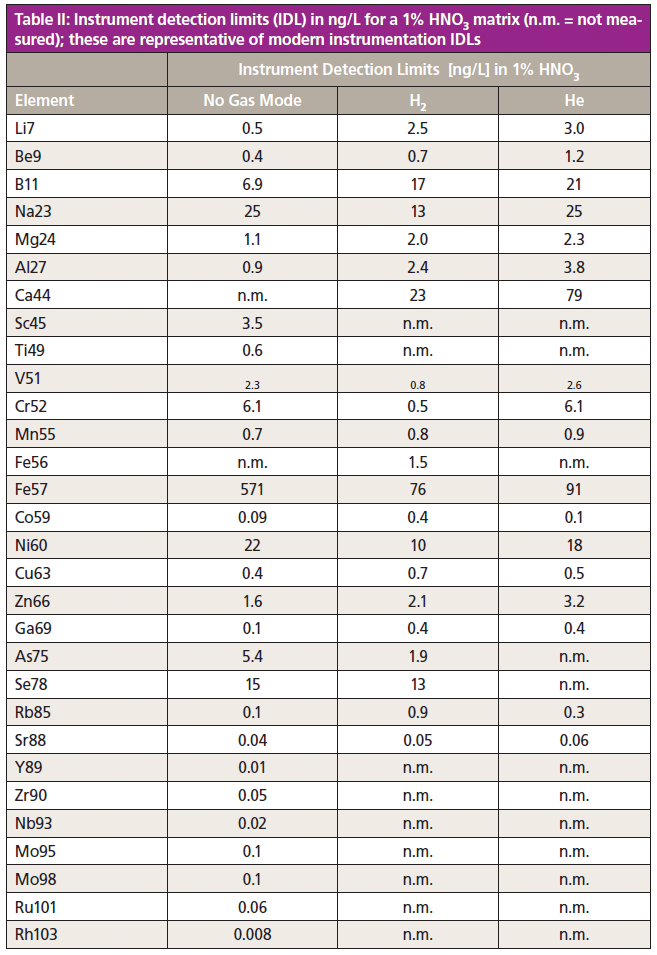
Results and Discussion
The instrument detection limits (IDL) obtained from the calibration curves were calculated by performing a noise analysis of the measured blank solution (3-sigma method), as described earlier (and listed in Table II). The detection limits in the sub ng/L [ppt]) range are the prerequisite for quantifying elements at ultratrace levels. Therefore, calibration graphs were generated for a suite of multielements, with the lowest calibration point close to the determined detection limit.
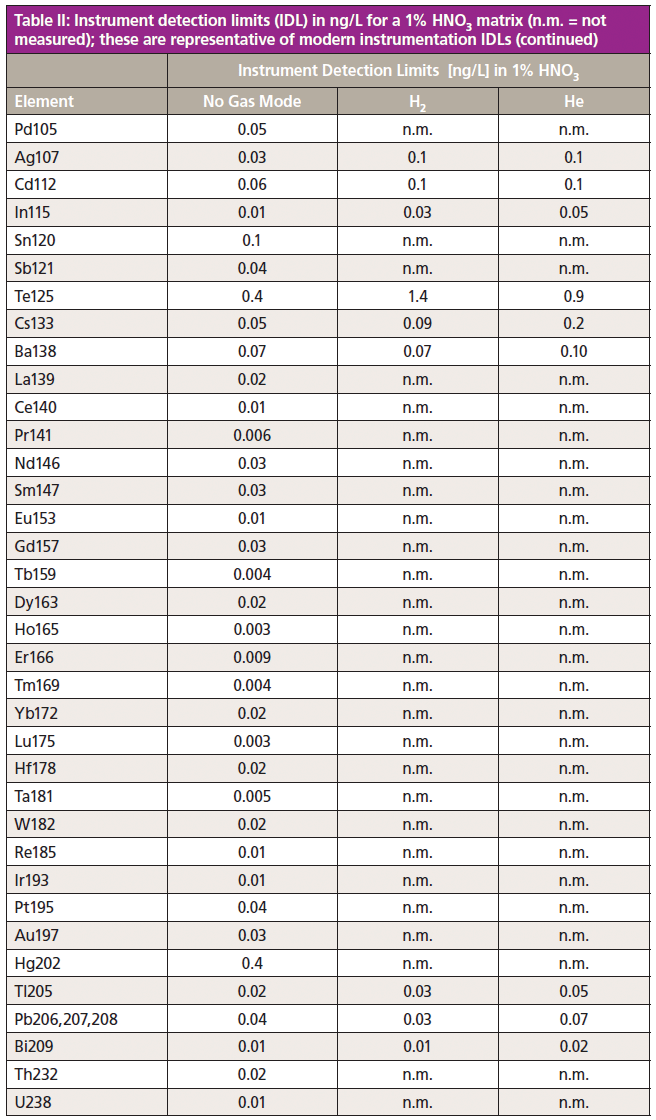
Calibration
Many regulated procedures require the first calibration standard to be near the LOQ to prove the linearity and correctness of the calibration function in this low concentration range. Calibration curves for 0-100 ng/L (ppt) of iron, cobalt, silver, and thallium, with the lowest standard at 3 or 5 ppt, are exemplified in Figure 3. The low standard deviations (from the regression functions) of the individual standards clearly shows that ultra high sensitivity and low noise results in a very high precision, which minimizes uncertainties and enables accurate calibration at very low parts per trillion (ppt) concentrations.
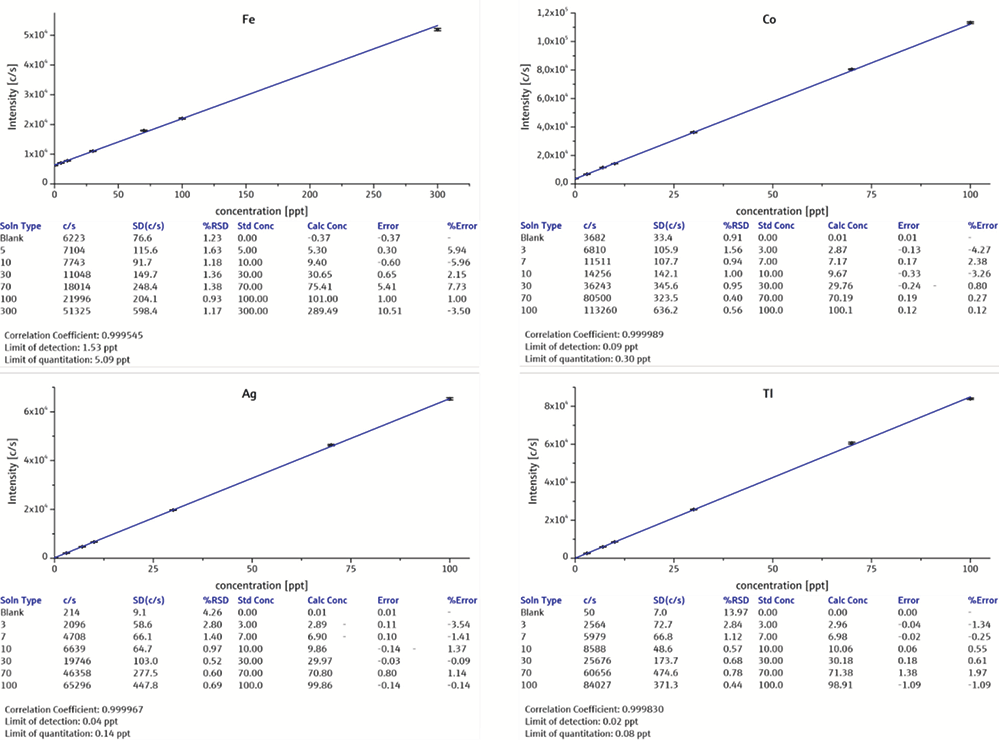
Figure 3: Four representative calibration graphs for transition metals (iron, cobalt, silver, and thallium) at sub ng/L (ppt) concentrations.
The capability of high sensitivity and low background noise also allows for the ultra-trace determination of rare earth elements. This is exemplified in Figure 4, which shows representative calibration curves for cerium, europium, terbium, and holmium using calibration standards from 0-1000 pg/L or parts per quadrillion (ppq) (6).
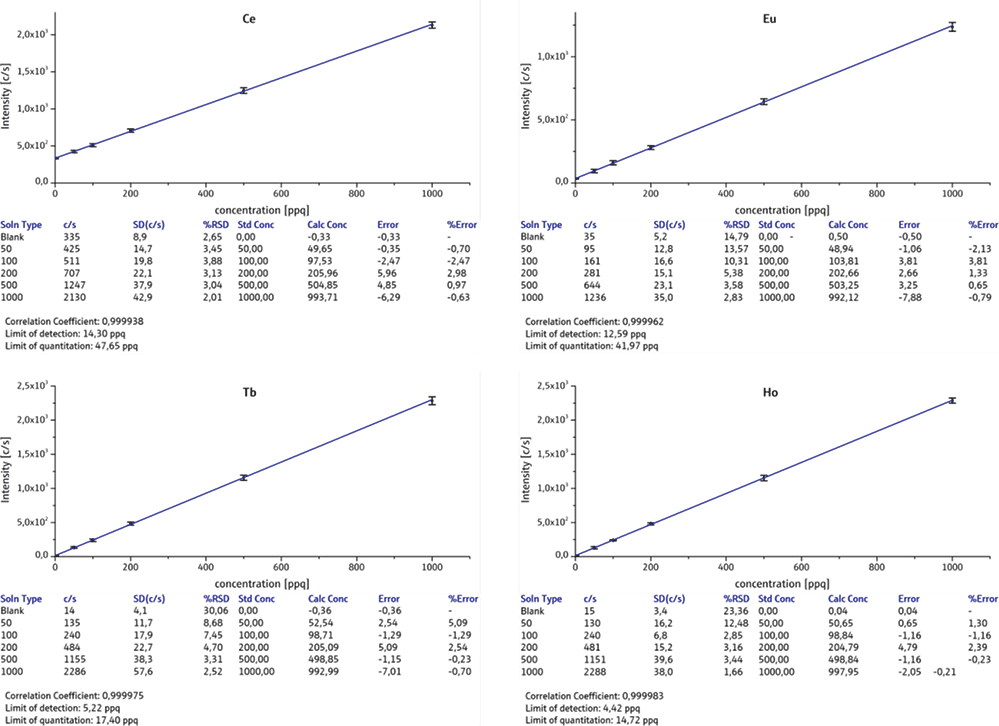
Figure 4: Four representative calibration graphs for rare earth elements (cerium, europium, terbium, and holmium) at pg/L (ppq) concentrations.
Conclusion
The instrument detection limits listed in this study are the concentrations that can be detected in a standard, non-cleanroom environment. For that reason, the contamination of the blank solution is the determining factor for the LOD for elements having a relatively high abundance. This highlights the necessity for high purity reagents, acid-washed containers and flasks, together with a clean and dust-free laboratory environment by using a laminar flow box to minimize contamination.
In addition, instrument design and performance optimization are equally important, because ultrahigh sensitivity and low background improve the signal-to-noise ratio, leading to lower detection limits. This is especially the case with low abundance elements, such as rare earth elements, where high sensitivity is achieved by careful optimization of the reflecting ion mirror, leading to pg/L (ppq) detection levels. This kind of performance is ideally suited for geochemical and other similar applications that require a precise and accurate quantitation of rare earth elements in mineral and rock samples. The study has therefore shown that the current generation of ICP-MS instrumentation can realistically achieve quantitation at the pg/L to ng/L concentration range in many varied and diverse sample matrices (7).
References
(1) "Definition and Procedure for the Determination of the Method Detection Limit," EPA Office of Water, Dec, 2016, https://www.epa.gov/sites/production/files/2016-12/documents/mdl-procedure_rev2_12-13-2016.pdf
(2) "Cleanboy clean room station," Spetec GmbH Website: https://trends.directindustry.com/spetec-gmbh/project-174749-147824.html
(3) "PlasmaQuant MS product details," Analytik Jena Website: https://www.analytik-jena.com/products/elemental-analysis/icp-ms/plasmaquant-ms/
(4) "PlasmaQuant MS Series: iCRC Technical Note," Analytik Jena Website, https://www.analytik-jena.com/fileadmin/content/products/PlasmaQuant_MS/TechNote_ICP_MS_iCRC_en.pdf
(5) "Improving Limits of Detection Using BOOST Technology," Analytik Jena Website: https://www.analytik-jena.com/fileadmin/content/applications/ICP-MS/AppNote_ICPMS_0024_en_01.pdf
(6) "Analysis of Geological Materials for Rare Earth Elements on the PlasmaQuant® MS Elite," Application Note, Analytik Jena Website: https://www.analytik-jena.com/fileadmin/content/applications/ICP-MS/AppNote_ICPMS_0011_en.pdf
(7) "PlasmaQuant applications page," Analytik Jena Website: https://www.analytik-jena.com/products/elemental-analysis/icp-ms/plasmaquant-ms/
About the Author
Rene Chemnitzer

Rene Chemnitzer is an ICP-MS Product Manger, with over 15 years experience in the field of trace element analysis, for Analytik Jena, in Jena, Germany.
About the Column Editor
Robert Thomas

Robert Thomas is principal of Scientific Solutions, a consulting company that serves the application and writing needs of the trace element user community. He has worked in the field of atomic and mass spectroscopy for more than 40 years and has written over 100 technical publications including a 15-part tutorial series on ICP-MS. He recently completed his fourth textbook entitled Measuring Elemental Impurities in Pharmaceuticals: A Practical Guide. He has an advanced degree in analytical chemistry from the University of Wales, UK, and is also a Fellow of the Royal Society of Chemistry (FRSC) and a Chartered Chemist (CChem).

Applications of Micro X-Ray Fluorescence Spectroscopy in Food and Agricultural Products
January 25th 2025In recent years, advances in X-ray optics and detectors have enabled the commercialization of laboratory μXRF spectrometers with spot sizes of ~3 to 30 μm that are suitable for routine imaging of element localization, which was previously only available with scanning electron microscopy (SEM-EDS). This new technique opens a variety of new μXRF applications in the food and agricultural sciences, which have the potential to provide researchers with valuable data that can enhance food safety, improve product consistency, and refine our understanding of the mechanisms of elemental uptake and homeostasis in agricultural crops. This month’s column takes a more detailed look at some of those application areas.
Trending on Spectroscopy: The Top Content of 2024
December 30th 2024In 2024, we launched multiple content series, covered major conferences, presented two awards, and continued our monthly Analytically Speaking episodes. Below, you'll find a selection of the most popular content from Spectroscopy over the past year.